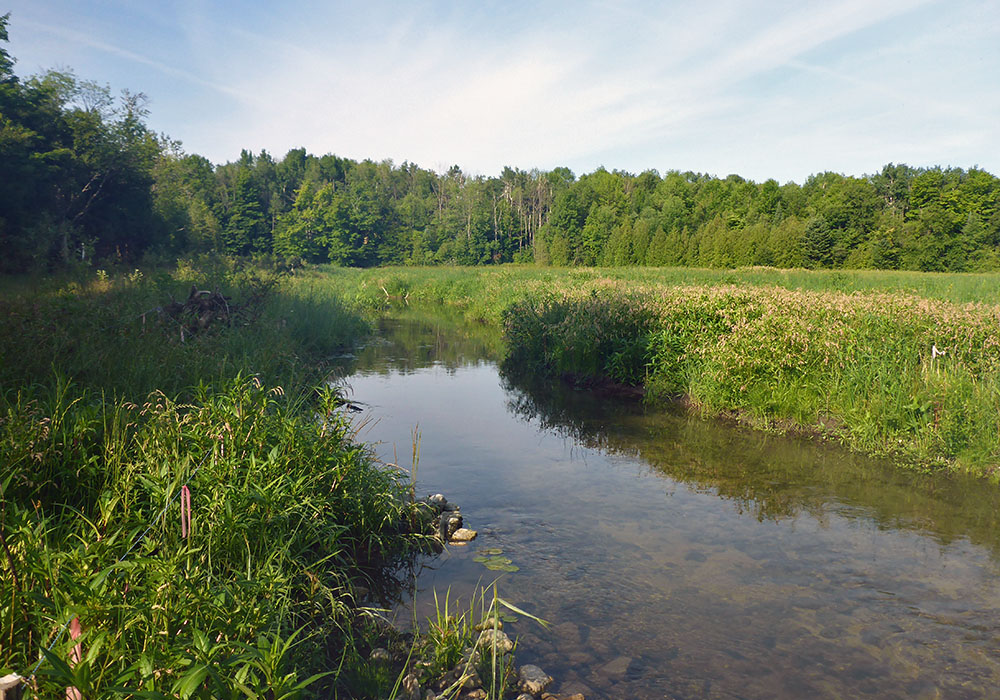
You are welcome to republish this story through the Creative Commons license CC BY-NC-SA 4.0. Where republishing conditions differ for images, this is noted in individual captions. (See this page for more information.)
By Linda Heron
Linda is Chair of the Ontario Rivers Alliance.
Part one of this story can be found here. The story continues below…
Brook trout
Most of the dam removal projects with which the Ontario Rivers Alliance has been involved have aimed to increase resilience to climate change by improving water quality, reducing stream temperature, and increasing brook trout habitat. To date, the Ontario Rivers Alliance has worked with several partners to open up over 50 km of additional brook trout habitat.

Brook trout are a highly sensitive cold-water species, and their survival relies on stream temperatures being no greater than 19oC–20oC for any sustained period of time. Their optimum growth temperatures are between 13oC and 16oC, and the upper incipient lethal temperature is 25.3oC, with a 7-day maximum mean tolerance temperature of 22.3oC.
Southern Ontario has lost more than 80% of its resident brook trout populations over the last 70 years, and the Ontario Government projects that annual average air temperatures in Southern Ontario will rise by 4°C over the next 50 years (as discussed in this presentation). This does not bode well for the future of brook trout unless we find ways to significantly improve the resilience of their freshwater ecosystems. Dam removal is one of the most effective ways to quickly lower stream temperature, open up additional habitat, and increase stream resilience to climate change.
In 2017, the Ontario Rivers Alliance partnered with Credit Valley Conservation, the Ministry of Natural Resources and Forestry, and others, in the Rudd Dam Removal Project on the West Credit River. It was our first dam removal project, which reconnected 1.5 km of high-quality brook trout habitat.

The Ontario Rivers Alliance is one of six working partners that make up the Coalition for the West Credit River. We came together as a Coalition to protect this at-risk population of brook trout from the negative environmental effects of the Erin Wastewater Treatment Plant, which should be in operation by sometime in 2025.
The West Credit River has one of the few remaining self-sustaining native brook trout populations in Southern Ontario. Consequently, we continue to work towards more dam removals.

Dam removal is a win–win
Dam removal brings a variety of benefits to local communities, including restoring river health and clean water, revitalizing fish and wildlife, improving public safety and recreation, and enhancing local economies.
— American Rivers
As noted in part one, decommissioning a dam removes a significant and ongoing source of greenhouse gas emissions. In addition, healthy riverine ecosystems are carbon sinks and are more resilient to a warming climate. Therefore, removing defunct dams would improve water quality, increase stream resilience, and quickly transform a methane emitter into a carbon sink. It is a win–win for nature and for humanity.

Unfortunately, very little funding is available for dam removal because when these dams were constructed, there were no up-front decommissioning funds required to facilitate their removal at the end of life. New dam proponents are still not required to place sufficient up-front funds in trust for the dam’s eventual decommissioning.
Even today, a basic mitigation measure, such as the installation of fish ladders at hydropower facilities and other dams, is rarely a requirement. Despite known impacts on several migratory fish species in Ontario, only two or three fish ladders have been installed at the 224 existing hydropower facilities in the province.
What the Ontario Rivers Alliance is doing
The Ontario Rivers Alliance is now in its fourteenth year of operation . We are a volunteer grassroots not-for-profit organization with a mission to protect, conserve, and restore Ontario riverine ecosystems. In our initial five years, we were dedicated to addressing a multitude of new hydroelectric proposals, and through diligent focus and attention to detail we successfully stopped 24 developments on a dozen rivers.
Since 2016, the Ontario Rivers Alliance has advocated and engaged with regulators, municipalities, environmental organizations, and individuals working towards the removal of unsafe and environmentally harmful dams. To date, the Ontario Rivers Alliance has partnered with conservation authorities and others in five dam removal projects and is awaiting the removal of four more. Our team continues to build compelling arguments to enlighten dam owners about the many benefits of removing dams. The Ontario Rivers Alliance has been a funding partner in several dam removal projects through crowdfunding and grant writing; however, it is always challenging to raise the required funds. If you are inclined, check out the petition on our website.


One thought on “Dam removal for climate and nature [Eastern Canada] – part two”
Comments are closed.